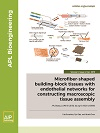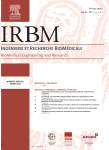
BME Frontiers
Scope & Guideline
Pioneering Insights for Tomorrow's Medical Technologies
Introduction
Aims and Scopes
- Biomedical Imaging and Sensing:
The journal emphasizes advancements in imaging modalities and sensing technologies, including novel applications of optical, ultrasound, and photoacoustic imaging for diagnostic and therapeutic purposes. - Nanotechnology in Medicine:
A significant focus on the design, application, and efficacy of nanomaterials and nanoparticles in drug delivery, cancer therapy, and combating antimicrobial resistance, reflecting the growing importance of nanotechnology in healthcare. - Artificial Intelligence and Machine Learning:
The integration of AI and machine learning techniques in medical diagnostics, imaging analysis, and healthcare solutions is a key area of research, showcasing the journal's commitment to leveraging technology for improved patient outcomes. - Tissue Engineering and Regenerative Medicine:
Research on tissue engineering, including bioreactors, scaffolds, and organoids, is prevalent. This area explores the development of functional tissues for transplantation and repair. - Drug Delivery Systems:
The journal features studies on innovative drug delivery methods, including stimuli-responsive systems and targeted therapies, particularly for cancer treatment and chronic conditions. - Clinical Applications and Health Technologies:
BME Frontiers addresses the translation of engineering innovations into clinical practice, focusing on technologies that enhance healthcare accessibility, diagnostics, and therapeutic interventions.
Trending and Emerging
- Functional Neural Interfaces:
Recent papers indicate a growing interest in functional neural networks and interfaces, particularly in the context of brain organoids and targeted therapies for neurological disorders. - Smart and Responsive Drug Delivery Systems:
Innovative drug delivery platforms that utilize smart materials and nanotechnology for controlled release and targeted action are increasingly prominent, showcasing the journal's focus on precision medicine. - AI-Driven Healthcare Solutions:
There is a marked increase in research exploring AI applications in healthcare, particularly for diagnostics, imaging analysis, and personalized treatment plans, reflecting a broader trend towards digital health. - Multimodal Imaging Techniques:
Emerging trends highlight the integration of multimodal imaging techniques that combine different imaging modalities to enhance diagnostic capabilities and therapeutic monitoring. - Sustainable Biomedical Materials:
Research on biodegradable and bioresorbable materials for medical applications is gaining momentum, emphasizing the need for sustainable practices in biomedical engineering.
Declining or Waning
- Traditional Biomedical Devices:
Research centered around conventional biomedical devices, such as basic diagnostic equipment, appears to be declining as the focus shifts towards more advanced, integrated technologies. - Basic Biological Studies:
Papers that delve deeply into basic biological mechanisms without a clear engineering or application perspective are less frequently published, indicating a trend towards more applied research. - Static Imaging Techniques:
There is a noticeable reduction in the exploration of static imaging techniques as dynamic and real-time imaging modalities gain more attention in the context of biomedical applications. - Invasive Surgical Techniques:
Research focusing on traditional invasive surgical methods is waning, possibly as minimally invasive and non-invasive techniques are preferred due to their lower risk and better patient outcomes. - Conventional Drug Formulation Studies:
Studies centered solely on conventional drug formulation without the integration of novel delivery technologies or nanotechnology are becoming less frequent in the journal.
Similar Journals

Physical and Engineering Sciences in Medicine
Bridging Disciplines for a Healthier TomorrowPhysical and Engineering Sciences in Medicine is an esteemed peer-reviewed journal published by SPRINGER, dedicated to advancing the interdisciplinary fields of biomedical engineering and biophysics. With an ISSN of 2662-4729 and an E-ISSN of 2662-4737, this journal has carved a niche for itself since its inception in 2020. Situated in the Netherlands, it serves as a global platform for innovative research and developments that bridge the physical sciences and engineering with medical applications. The journal boasts a commendable range of quartile categorizations, highlighting its impact in various sectors including Instrumentation (Q1), Radiology (Q2), and Biotechnology (Q2). Its Scopus rankings further emphasize its relevance and quality, placing it in the top 15% in several categories. Being an Open Access title, it promotes the dissemination of knowledge, ensuring that vital research is accessible to all, thereby fostering collaboration among researchers, professionals, and students alike. The journal's objectives include promoting cutting-edge research, enhancing biomedical technology, and addressing complex health challenges through innovative engineering solutions, establishing it as a vital resource in the scientific community.

APL Bioengineering
Transforming Ideas into Bioengineering BreakthroughsAPL Bioengineering is a premier open-access journal published by AIP Publishing, dedicated to advancing the field of bioengineering and its interdisciplinary applications. Established in 2017, this journal serves as a vital platform for researchers, professionals, and students interested in the critical intersections of bioengineering, biomaterials, biomedical engineering, and biophysics. With an impressive impact factor and consistent rankings in the Q1 category across multiple domains, including biochemistry and materials science, APL Bioengineering has positioned itself among the top journals in its field. The journal aims to publish innovative original research, comprehensive reviews, and insightful case studies that further the understanding and application of bioengineering principles. Since its inception, APL Bioengineering has fostered a community of thought leaders, providing open access to ensure broad dissemination of knowledge and advancements that underpin the future of biomedical innovation.

Biomedical Engineering-Biomedizinische Technik
Empowering Professionals with Insightful Biomedical ResearchBiomedical Engineering-Biomedizinische Technik, published by WALTER DE GRUYTER GMBH, serves as a pivotal platform for advancing knowledge in the field of biomedical engineering and medicine since its inception in 1956. With an ISSN of 0013-5585 and an E-ISSN of 1862-278X, this peer-reviewed journal offers accessible insights into innovative research and technological advancements that are reshaping healthcare practices and biomedical applications. Although rated in the Q3 category for both Biomedical Engineering and Miscellaneous Medicine in 2023, the journal's impact factor and growing reputation demonstrate its vital role in fostering academic dialogue and collaboration. The journal is based in Germany, while its scope encompasses a diverse range of topics, thus bridging the gap between engineering and medical disciplines. Researchers, professionals, and students alike are encouraged to engage with the content that not only highlights contemporary challenges but also presents groundbreaking solutions in biomedical technology.

Bioengineering-Basel
Driving Excellence in Bioengineering ResearchBioengineering-Basel, an esteemed journal published by MDPI, stands at the forefront of innovation in the field of bioengineering since its inception in 2014. With an E-ISSN of 2306-5354, this fully Open Access journal based in Switzerland provides a platform for researchers and professionals to disseminate cutting-edge findings across various aspects of bioengineering, including biomaterials, tissue engineering, and biopharmaceuticals. The journal has been recognized with a Q3 ranking in the 2023 Bioengineering category, reflecting its commitment to quality and relevance. By facilitating widespread accessibility to academic knowledge, Bioengineering-Basel aims to foster collaboration and stimulate thought leadership within the global research community, making it an indispensable resource for students, scholars, and industry practitioners alike.

Biomedical Engineering Letters
Exploring the intersection of engineering and medicine.Biomedical Engineering Letters, published by SpringerNature, is a prominent journal in the field of Biomedical Engineering. With a robust ISSN of 2093-9868 and E-ISSN of 2093-985X, this esteemed journal has established itself as a vital resource for researchers and professionals seeking to advance their knowledge and share groundbreaking findings. Recognized for its quality, Biomedical Engineering Letters holds a distinguished ranking in Scopus, positioned at #94/303 (69th percentile) in the Biomedical Engineering category. The journal covers a diverse scope within biomedical engineering, providing an important platform for innovative research from 2011 to 2024 and facilitating the exchange of ideas among scholars. Although it operates under a subscription model, the journal's commitment to enhancing the field makes it an indispensable reference for those engaged in cutting-edge biomedical research in Germany and globally.

Journal of Mechanics in Medicine and Biology
Harnessing Mechanics to Revolutionize HealthcareThe Journal of Mechanics in Medicine and Biology, published by World Scientific Publishing Co Pte Ltd, serves as a critical platform for interdisciplinary research at the intersection of engineering and biomedical sciences. With an ISSN of 0219-5194 and E-ISSN of 1793-6810, this esteemed journal has been dedicated to exploring the mechanical principles that govern biological systems since its inception in 2008. Based in Singapore, it addresses a diverse range of topics, from biomaterials to biomechanics, contributing valuable insights into the field’s evolving landscape. Although currently positioned in Q4 of Biomedical Engineering according to the 2023 category quartiles, it is poised for growth and increased visibility within the scientific community, fostering innovation and collaboration among researchers, professionals, and students alike. The journal emphasizes the importance of cutting-edge research and its practical implications, making it a vital resource for those striving to enhance the future of medical technologies and biological understanding.

Nature Biomedical Engineering
Exploring New Horizons in Biomedical EngineeringNature Biomedical Engineering is a premier journal published by NATURE PORTFOLIO, focusing on innovative research at the intersection of engineering and biomedical sciences. With an ISSN of 2157-846X, this journal aims to disseminate groundbreaking studies that advance the field of bioengineering, biotechnology, and medical applications. Since its inception in 2017, it has rapidly earned a reputation for excellence, consistently achieving a Q1 ranking in various categories including Bioengineering and Biomedical Engineering, and receiving acclaim in prestigious Scopus rankings, boasting top positions in the fields of Computer Science Applications and Medicine. The journal operates under a rigorous peer-review process, ensuring that all published articles contribute substantially to the existing body of knowledge. Furthermore, it facilitates a broad accessibility model for researchers and practitioners, bolstering collaboration and innovation within the global scientific community. Nature Biomedical Engineering is not just a publication; it serves as a vital platform for thought leadership in the transformative field of biomedical engineering.

Bioengineering & Translational Medicine
Connecting Science and Medicine for Impactful OutcomesBioengineering & Translational Medicine, published by WILEY, positions itself at the forefront of innovation in the fields of biomedical engineering, biotechnology, and pharmaceutical science. With an impressive impact factor reflected through its top-tier Q1 rankings in multiple categories, the journal serves as a critical platform for disseminating cutting-edge research and stimulating discourse among professionals and scholars since its establishment as an open-access journal in 2016. Key to its mission is facilitating the translation of bioengineering research into tangible medical applications, thereby enhancing healthcare outcomes. With its comprehensive scope, it attracts a diverse readership, including researchers, industry leaders, and students eager to engage with the latest developments in translational medicine. The journal operates under robust access options, ensuring that research is freely available for maximum reach and impact, fostering collaboration and innovation across disciplines worldwide.

BIOMEDICAL ENGINEERING-APPLICATIONS BASIS COMMUNICATIONS
Bridging technology and medicine for a healthier world.BIOMEDICAL ENGINEERING-APPLICATIONS BASIS COMMUNICATIONS is a prominent journal dedicated to the dynamic field of biomedical engineering, published by WORLD SCIENTIFIC PUBL CO PTE LTD. Since its inception in 1992, the journal has provided a platform for the dissemination of high-quality research and innovative applications within the biomedical engineering domain. Despite its current Q4 ranking in multiple categories such as Bioengineering and Biomedical Engineering, the journal serves as an essential resource for researchers and professionals seeking to explore the latest developments and practical applications in this interdisciplinary field. The journal is based in Singapore, reflecting the region's growing influence in scientific research and technology. Although it does not offer open access, it continues to attract submissions that enrich the scientific dialogue within its community. With a commitment to fostering knowledge and research collaboration, this journal remains a vital contributor to the ongoing advancements in biomedical technology and engineering.

IRBM
Pioneering Innovations in Biomedical Engineering and BiophysicsIRBM, published by Elsevier Science Inc, stands at the forefront of research in the domains of Biomedical Engineering and Biophysics, boasting impressively high rankings with a Q1 category in both fields according to the 2023 evaluations. With an effective focus on cutting-edge innovations and methodologies, IRBM provides a vital platform for researchers, professionals, and students alike seeking to disseminate and access groundbreaking findings and developments. Its strong presence in the Scopus database, with ranks of #12 in Biochemistry, Genetics and Molecular Biology and #42 in Biomedical Engineering, places it in the top percentile of impactful journals in the field, making it a crucial resource for advancing knowledge and fostering collaboration. While the journal maintains a traditional subscription model, it continues to attract a diverse readership eager for insightful studies and reviews that push the boundaries of science and engineering. With a projected convergence of years extending to 2024, IRBM promises to remain a significant contributor to the ongoing dialogue in the life sciences.